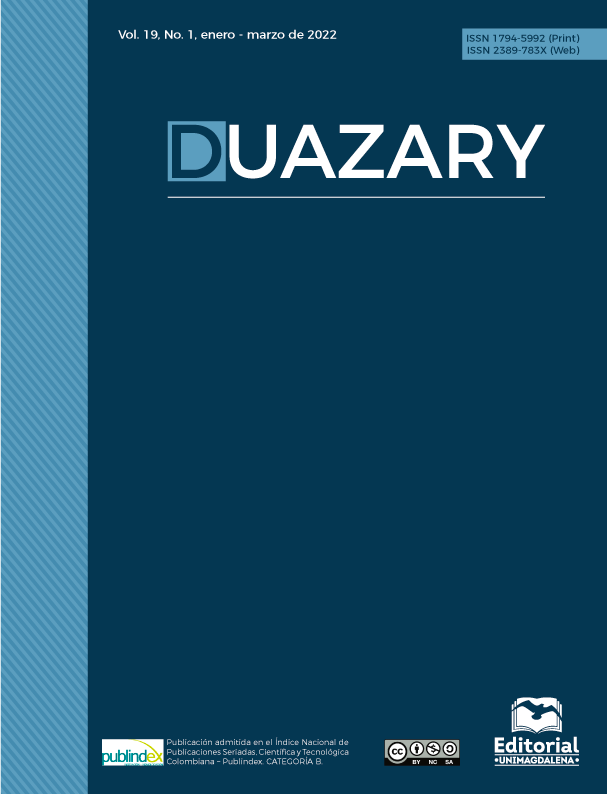Índices de shock y shock modificado en el puerperio inmediato
Contenido principal del artículo
Resumen
Los parámetros que definen el shock ―como taquicardia, hipotensión y pobre perfusión del órgano final― no son totalmente aplicables a la paciente obstétrica por los cambios fisiológicos que dificultan establecer puntos de corte para desencadenar intervenciones clínicas. Sin embargo, una relación de ellos puede generar un indicador más preciso de hipovolemia llamado índice de shock (IS) e índice de shock modificado (ISM). Se realizó un estudio de corte transversal con el objetivo de establecer la mediana del IS y del ISM, desviación estándar (DS) e intervalo de confianza del 95% (IC95), a los 30 minutos, a la hora y a las dos horas. Los valores en los diferentes momentos se compararon con un test de ANOVA y de acuerdo con la vía del parto mediante rangos de Wilcoxon. Se calcularon coeficientes de correlación de Spearman entre el ISM, la edad de las pacientes y la edad gestacional. Las medianas del IS y del ISM fueron de 0,669 (DS: 0,014; IC95: 0,664-0,692) y 0,922 (DS: 0,019; IC95: 0,914-0,949), respectivamente. No se encuentra ninguna correlación de estos valores con las edades de las pacientes o la edad gestacional.
Descargas
Detalles del artículo

Esta obra está bajo una licencia internacional Creative Commons Atribución-NoComercial-CompartirIgual 4.0.
No se permite un uso comercial de la obra original ni de las posibles obras derivadas, la distribución de las cuales se debe hacer con una licencia igual a la que regula la obra original.
Citas
DeMuro JP, Simmons S, Jax J, Gianelli SM. Application of the shock index to the prediction of need for hemostasis intervention. Am J Emerg Med. 2013; 31(8): 1260-3. Doi: http://dx.doi /10.1016/j.ajem.2013.05.027
Schroll R, Swift D, Tatum D, Couch S, Heaney JB, Llado-Farrulla M, et al. Accuracy of shock index versus ABC score to predict need for massive transfusion in trauma patients. Injury, Int J Care Injured. 2018; 49: 15-9. Doi: https://doi.org/10.1016/j.injury.2017.09.015
Lyon M, Blaivas M, Brannam L. Sonographic measurement of the inferior vena cava as a marker of blood loss. Am J Emerg Med 2005; 23(1): 45-50. Doi: https://doi.org/10.1016/j.ajem.2004.01.004
Guerrero-De León MC, Escárcega-Ramos LR, González-Días OA, Palomares- Leal A, Gutiérrez-Aguirre CH. Utilidad del índice de choque como valor predictivo para el requerimiento de trasfusión en hemorragia obstétrica. Ginecol Obstet Méx. 2018; 86(10): 665-74. Doi: http://dx.doi /10.24245/gom.v86i10.2346
Terceros-Almanza LJ, García-Fuentes C, Bermejo-Aznárez S, Prieto-del Portillo IJ, Mudarra-Reche C, Sáez-de la Fuente I, et al. Predicción de hemorragia masiva. Índice de shock e índice de shock modificado. Med Intensiva. 2017; 41(9): 532-8. Doi: http://dx.doi 10.1016/j.medin.2016.10.016
Borovac-Pinheiro A, Pacagnella RC, Cecatti JG, Miller S, El Ayadi AM, Souza JP, et al. Postpartum hemorrhage: New insights for definition and diagnosis. Am J Obstet Gynecol. 2018; 219(2): 162-8. Doi: https://doi.org/10.1016/j.ajog.2018.04.013
Witting MD. Standing shock index: An alternative to orthostatic vital signs. Am J Emergency Med. 2017; 35(4): 637-9. Doi: http://dx.doi /10.1016/j.ajem.2016.12.052
Vousden N, Nathan HL, Shennan AH. Innovations in vital signs measurement for the detection of hypertension and shock in pregnancy. Reproductive Health. 2018; 15(Suppl 1): 89-91. Doi: http://dx.doi /10.1186/s12978-018-0533-4
Chung J-Y, Hsu, Ch-Ch, Chen J, Chen W-L, Lin H-J, et al. Shock index predicted mortality in geriatric patients with influenza in the emergency department. Am J Emergency Med. 2018. Doi: https://doi.org/10.1016/j.ajem.2018.05.059
Kristensen AK, Holler JG, Hallas J, Lassen A, Shapiro N. Is the shock index a universal predictor in the emergency department? A cohort study. Critical Care. 2015; 19(Suppl 1): P148. Doi: http://dx.doi 10.1186/cc14081
Tseng J, Nugent K. Utility of the Shock Index in Patients with Sepsis. Am J Med Sci 2015; 349(6): 531-5. Doi: https://doi.org/10.1097/MAJ.0000000000000444
Eppes CS, Schupp J, Dildy D. Shock Index: A potential criterion for a maternal early warning system. Am J Obstet Gynecoog. 2016; (January): S159. Doi: https://doi.org/10.1016/j.ajog.2015.10.311
Pacagnella RC, Souza JP, Durocher J, Perel P, Blum J, Winiko B, et al. A Systematic Review of the Relationship between Blood loss and Clinical Signs. PLOS ONE. 2013; 8(6): e57594. Doi: http://dx.doi:10.1371/journal.pone.0057594
Jaramillo S, Barnhart K, Takacs P. Use of the shock index to predict ruptured ectopic pregnancies. Int J Gynaecol Obstet. 2011; 12(81): 68. Doi: http://dx.doi/10.1016/j.ijgo.2010.08.005
Guzmán-Polanía L, Paternina-Caicedo A, Tolosa JE, Rojas-Suárez J. Descripción del índice de choque en el embarazo [Tesis de grado. Especialista en Ginecología y Obstetricia]. Cartagena: Universidad de Cartagena. Facultad de Medicina; 2013.
Liu Y, Liu J, Fang Z, Shan G, Xu J, Qi Z, et al. Modified shock index and mortality rate of emergency patients. World J Emerg Med 2012; 3(2): 114-7. Doi: http://dx.doi/10.5847/wjem.j.issn.1920-8642.2012.02.006
Guyton A, Hall H. Tratado de fisiología médica. 13 edición. Barcelona, España: Elsevier; 2016.
Sharma A, Satish U, Tevatia MS, Singh SK. Prehospital shock index, modified shock index, and pulse pressure heart rate ratio as predictors of massive blood transfusions in modern warfare injuries: A retrospective analisis. Med J Armed Forces India. 2019; 75: 171-5. Doi: https://doi.org/10.1016/j.mjafi.2018.07.002
Strehlow MC. Early identification of shock in critically ill patients. Emerg Med Clin N Am 2010; 28: 57-66. Doi: http://dx.doi: 10.1016/j.emc.2009.09.006
Birkhahn RH, Gaeta TJ, Bei R, Bove JJ. Shock index in the first trimester of pregnancy and its relationship to ruptured ectopic pregnancy. Academic Emergency Medicine 2002; 9: 115-9. Doi: https://doi.org/10.1197/aemj.9.2.115
Nathan L, Cottam K, Hezelgrave NL, Seed PT, Briley A, Bewley S, et al. Determination of Normal Ranges of Shock Index and Other Haemodynamic Variables in the Immediate Postpartum Period: A Cohort Study. PLOS ONE. 2016; 11(12): e0168535 Doi: http://dx.doi /10.1371/journal.pone.0168535
Le Bas A, Chandraharan E, Addei A, Arulkumaran S. Use of the “obstetric shock index” as an adjunct in identifying significant blood loss in patients with massive postpartum hemorrhage. Int J Gynecol Obstet. 2014; 124: 253-5. Doi: https://doi.org/10.1016/j.ijgo.2013.08.020

